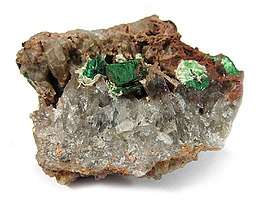Volborthite
| Volborthite | |
|---|---|
 Neon green crystals of volborthite are nestled in a vug in the matrix | |
| General | |
| Category | Polyvanadate minerals |
| Formula (repeating unit) | Cu3V2O7(OH)2·2H2O |
| Strunz classification | 8.FD.05 |
| Dana classification | 40.03.10.01 |
| Crystal system | Monoclinic |
| Crystal class |
Prismatic (2/m) (same H-M symbol) |
| Space group | C2/m |
| Unit cell |
a = 10.610(2) Å, b = 5.866(1) Å c = 7.208(1) Å; β = 95.04(2)°; Z = 2 |
| Identification | |
| Color | Olive-green, yellow-green; green to yellow-green in transmitted light |
| Crystal habit | Aggregates of scaly crystals, rosettes |
| Cleavage | Perfect |
| Mohs scale hardness | 3 1⁄2 |
| Luster | Vitreous, waxy, greasy, pearly |
| Streak | light green |
| Diaphaneity | Translucent |
| Specific gravity | 3.5 - 3.8 |
| Optical properties | Biaxial (+/-) |
| Refractive index | nα = 1.793 nβ = 1.801 nγ = 1.816 |
| Birefringence | δ = 0.023 |
| Pleochroism | Weak |
| 2V angle | Measured: 63° to 83° |
| Dispersion | Translucent to Subtranslucent |
| Ultraviolet fluorescence | Non-fluorescent |
| Solubility | Soluble in acids |
| References | [1][2][3] |
Volborthite is a mineral containing copper and vanadium, with the formula Cu3V2O7(OH)2·2H2O. Found originally in 1838 in the Urals, it was first named knaufite but was later changed to volborthite for Alexander von Volborth (1800–1876), a Russian paleontologist.[4]
Tangeite (synonym: calciovolborthite), CaCuVO4(OH), is closely related.
Occurrence
Volborthite was first described in 1837 for an occurrence in the Sofronovskii Mine, Yugovskii Zavod, Perm, Permskaya Oblast, Middle Urals, Russia.[2]
It occurs as an uncommon oxidation mineral in vanadium bearing hydrothermal copper ores. It is associated with brochantite, malachite, atacamite, tangeite, chrysocolla, baryte and gypsum.[1]
References
This article is issued from
Wikipedia.
The text is licensed under Creative Commons - Attribution - Sharealike.
Additional terms may apply for the media files.